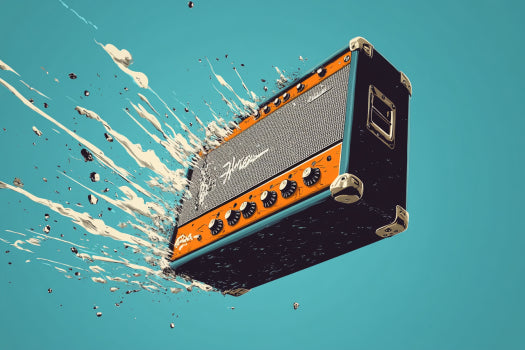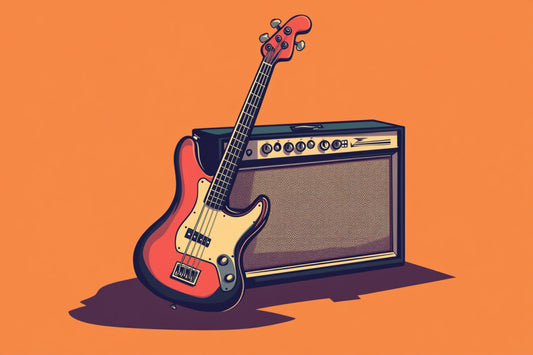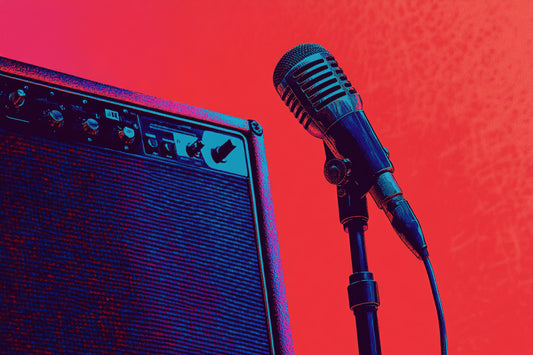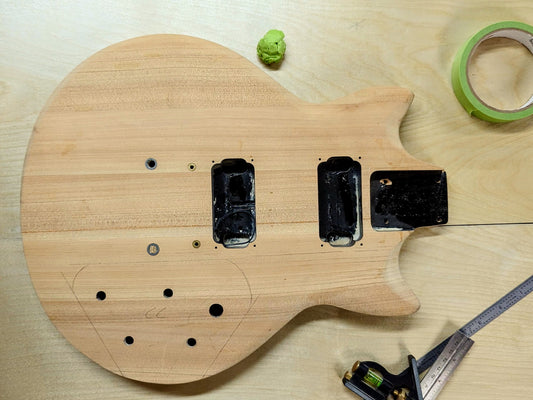
Project Icarus started off life as an Ibanez GAX70. It was my first guitar, bought when I was 12 years old after saving up by working odd jobs (mostly doing unnecessary chores for my parents so they could teach me a life lesson). And I loved it. I loved the way it looked, the way it felt, the way my fingertips throbbed after hours of fumbling around trying to figure out how music worked.
I was terrible, of course.
There is no other way to be in the beginning. But it didn’t matter that I was terrible because I learned something new every time I sat down to play. I quickly took possession of a couple acoustic guitars as well, but this Ibanez was the one that got hauled around everywhere with me.
I made my first music friends with that guitar. Formed my first band with it. Played my first show.
There was a time when that instrument was everything to me. When it didn’t matter how much crap I had to lug around, as long as it was waiting for me in quiet moments.
But truthfully, it never sounded all that great. Not to me, anyway. Tinny and thin, made worse by the gutless solid-state practice amps I was playing through back then, and definitely by my lack of experience and knowledge with such elusive and technical mysteries as “EQ Settings.”
Not to mention that it was heavy as hell. A real backbreaker. Especially when played so low-slung that you actually have to hunch down just to reach the strings…
So I moved on.
Hacked up a Squier Strat with a friend of mine. Turned it into a punk rock hatchet job with highly unstable and unprofessional “hotrod” mods including such hits as: aluminum foil cavity shielding, terrible solder connections, and “What exactly do you mean by intonation?” Dubbed the “FrankenStrat” with absolutely no conception that another very famous guitar might bear that name, it became my main squeeze for the next handful of years, before I switched to almost exclusively acoustic playing (that phase would last nearly a decade).
And the Ibanez sat in a case. It moved whenever I did. Got stored wherever the rest of my gear lived. I would take it out every once in a while, give it a session, and remember why I never liked playing it.
It slowly deteriorated as I graduated college. Survived admirably in a rollover car crash at highway speed as I was moving myself to Washington. Continued to sit in its case in a closet while I commuted day in and day out across Puget Sound, riding my little green bicycle onto a ferry to go work in a Seattle weed-candy factory. It sat in darkness while I built my first “real” workshop in the basement of that rented house in Bremerton.



I learned a lot about building in that shop, including the limitations of flying by the seat of my pants (though that lesson would take years to fully sink in). My first decent piece of furniture was built down there: a coffee table that still gets use in our home today. I also built several… not so decent pieces in that shop, but I still miss it. Scavenging alleys for scrap material. Doing so much work on the floor… Okay, I don’t miss it that much.
But there’s nothing quite like the place where you discover something at the core of your being. That house will always be special to me for those reasons.
I did get a little bored of furniture after a while. Or, maybe I just ran out of scavenged material big enough to do anything real with. I’m not sure which. A guitar rebuild started sounding like an excellent idea.

Naturally, I spent far too much time planning. If I think my less-than-healthy mental/emotional/behavioral habits are hard to tamp down now, they were absolutely out of control back then. But eventually, after a decade of ownership and a good few years of utter neglect, I pulled the Ibanez out and started stripping it down.
At the core, electric guitars are really pretty simple (I think people overcomplicate them, but that’s a subject for another day). So, pulling the hardware took no time at all. Building a makeshift dust booth and actually stripping the paint however, that was a bit of a challenge.

I didn’t photograph my work much back then, but imagine if you will: a smallish room with hooks running in an even smaller circle around the ceiling. Each hook has been shoved through the thinnest plastic sheeting found at the local hardware store, reinforced with a zip-tie (plastic sheeting, like everything else, proved far more expensive than I had anticipated). A series of slits was cut in the sheeting near the two basement windows for “ventilation,” and the base of the sheeting was weighed down with… well, anything sufficiently heavy and useless. Oh, and newspaper all over the floors.
It was a nightmarish set up, littered with trip hazards and just begging for me to fall into (and through) the plastic walls. Which I did.
I was so proud when I finished it.

After untold hours of sanding in the “dust booth” wearing less-than-adequate breathing protection, I had finally removed all the paint from the Ibanez body. It could have gone much faster, but I made the poor man’s mistake of simply using sandpaper until it falls apart. The pores of any sandpaper clog up to near-complete ineffectiveness long before the paper starts to disintegrate, and the fear of screwing something up kept me from using aggressive enough grits to begin with. So, it took WAY longer than it should have.
But, it got done!
And all progress came to a screeching halt.
I've always thought this was because I couldn't bring myself to actually cut into the body and make a permanent change. But while looking at the few old photos of this project that exist, I realized that I had actually been brave enough to cut the horns back and reshape them a bit. Apparently it was concerns about color and design for stain or paintwork that held me back.
This is a familiar place I’ve come to call: Indecision Point. Like a physical location at the end of a path where there are an infinite number of directions to take and strategies to employ from there onward. Upon reaching Indecision Point, I become incapable of choosing any particular path for fear of the infinite possibilities I will leave behind by doing so.
The project stagnated before it could ever truly begin, which is the real trick of Indecision Point. It is, in effect, a mirage. It’s a place that only feels like a place; feels like you get halfway down the path before you must stop and choose. In truth, Indecision Point marks the beginning of the path. It is the moment that a project truly begins. Everything that has come before was only preparation. And like any journey, the moment you set off in one direction, what lies down the other paths becomes mostly impossible.
It is sorely tempting to consider every combination of possible choices and make sure to choose exactly the right one. But what gets chosen is almost always entirely unimportant -- or very nearly so. There is no perfect choice, and any idea or prediction of how a chosen path will unfold is essentially guaranteed to be wrong. The important thing is merely to choose.
Just choose.
Maybe not randomly, but choose without worrying too much.
I… did not choose.

The fire in my soul for that little project slowly died. The Ibanez’s naked body sat dormant in my makeshift dust booth for months before being haphazardly packed into a box with other guitar parts when I finally left Washington for good.
And there it remained. In that same box moving from state to state, closet to closet, for another decade as my life changed again and again. But it was always there. Always with me.
And here we are, in the present. I find myself in need of a project just like it, and it’s still here for me. What a friend.







